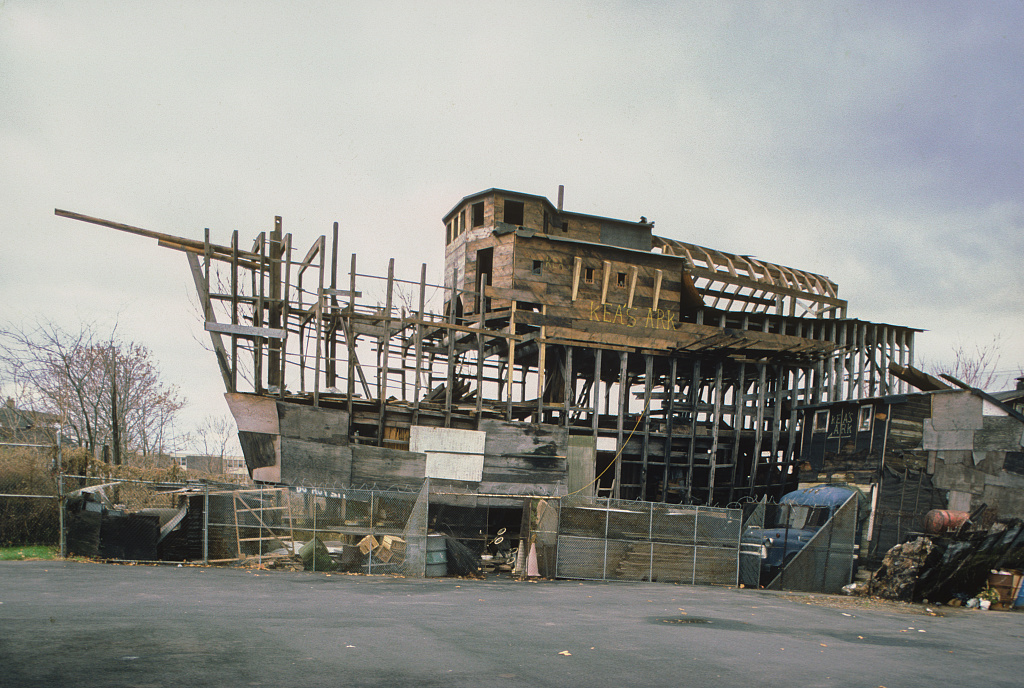
Kea Tawana’s Ark
Newark, New Jersey
Kea Tawana (1935-2016) began salvaging slate, stained glass windows, and timber from buildings in Newark’s Central Ward during the late 1960s, using only hand tools and a cart. An uprising during the Long Hot Summer of 1967, historically termed a “season of race riots,” was followed by yet more years of racial injustice and economic disinvestment which left many homes and businesses destroyed in the majority-black neighborhood. Asserting that “there’s no place safe on land,” Tawana began building an ark in the summer of 1982 on an abandoned lot high on a hill, next door to the Humanity Baptist Church where she worked as caretaker and guard. Utilizing timbers from fallen homes, Tawana constructed her boat with mortise-and-tenon joints, one of the strongest ways of joining wood. She employed crumbled slabs from old sidewalks as ballast; installed seats from a demolished movie theater; and gave a place of honor to a marble tablet from a long-lost chapel commemorating an early 20th century orphanage and the priest who founded it.
While Tawana’s obituary stated she had been born on an “Indian reservation,” Tawana told people she had been born in Japan, the daughter of an American civil engineer and his Japanese wife. It is agreed she was on her own by 12, working itinerant jobs in the South before hopping freight trains to the New York area. On the east coast, she worked in shipyards, on construction sites, and in theater rigging, acquiring all the skills on display in the form of Kea’s Ark. The frame of the boat – the AKE Matsu Kaisha (Red Pine), as it was meant to be christened — was 86 feet long, 20 feet wide, and 28 feet high, with five water-tight compartments and a bulkhead reinforced with iron. It was envisioned by Tawana as both a sculpture and seaworthy vessel.
The Ark was evicted in 1986 by a real estate developer that had purchased the property where it stood. At the invitation of the Humanity Baptist Church, Tawana moved the Ark to the church parking lot — by herself, over the course of four days, using jacks and rollers. In 1987, the City of Newark condemned Kea’s Ark for being unsafe, though no structural flaws were cited by the Newark Department of Engineering. Mayor Sharpe James went after the church for failing to evict Tawana, then slated Kea’s Ark for demolition. Tawana took Newark to court, where the Ark was defended as a work of art and example of protected free speech. In the summer of 1988, with only a temporary injunction, Tawana dismantled the Ark herself rather than witness its destruction. She relocated to Port Jervis, New York where she died in 2016.
“Kea’s Ark of Newark: A Life in Works”, a posthumous exhibition put on by Newark’s Gallery Aferro and the Clement A. Price Institute on Ethnicity, Culture, and the Modern Experience at Rutgers University-Newark, assembled the art and artifacts left by Tawana, including stained glass windows, handmade furniture, delicate jewelry and metal works, architectural drawings, photographs, and several cabinets of carefully bundled paper ephemera.
Resources:
Biography and photos
Video Kea’s Ark by Susan Wallner (26 minutes; 2021)
Button & Top Photo Credit: The Library of Congress
